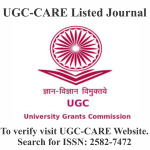QUANTIFYING MONOTONE CORRELATION IN VISUAL PATTERN ANALYSIS WITH MATHEMATICAL STATISTICS
DOI:
https://doi.org/10.29121/shodhkosh.v5.i5.2024.6598Keywords:
Monotone Correlation, Monotone Scale InvarianceAbstract [English]
A two-way frequency table that categorizes all corporate bonds rated by Standard & Poor's and Moody's, or the well-known father-son social mobility data matrix that is frequently cited as an example of a Markov chain in human resources, are two examples to consider. Given that bond ratings and social class have a similar natural ordering, both are instances of contingency tables with rows and columns that represent ordinal categorical variables. The degree of association between such row and column variables is measured and quantified in this study. When it comes to cardinal variables, correlation provides a clear indicator of linkage that doesn't require category scaling. A measure of connection could be calculated using sup correlation, a scheme similar to eigen analysis, if the order relationships involved do not need to be respected. Methods for ordinal categorical data, like Spearman's or Kendall's tau, assign numerical values to the categories. We introduce a few novel methods for assessing the correlation between ordinal variables. The idea of monotone correlation is used to develop four new statistical measures of monotone relationships. The particular circumstance that produced the data determines whether each of these metrics is appropriate. An iterative process is the only way to obtain these metrics of association. These metrics are evaluated and the corresponding monotone scalings are obtained using a nonlinear optimization approach.
References
A. Fiacco and G. MeCormick, Nonlinear Programming Sequential Unconstrained Minimiza tion
Techniques (Wiley, New York, 1968).
A. Renyi, “Measures of Dependence". Acta Math Acad. Sci. Hungar. 10 (1959) 441-451 DOI: https://doi.org/10.1007/BF02024507
D.V. Glass and 1.R. Hall, "Social Mobility in Britain: A Study of Intergeneration Changes in Status, in:D.V. Glass, ed., Social Mobility in Britain (Routledge and Kegan Paul Lid. London, 1954)
Fujita A, Takahashi DY, Balardin JB, Sato JR. Correlation between graphs with an application to brain
networks analysis. 2015. arXiv:1512.06830 [q-bio, stat]. Accessed 12 Jan 2020.
G. Kimeldorf and A.R. Sampson, "Monotone Dependence", Annals of Statistics 6 (1978) 895-903. DOI: https://doi.org/10.1214/aos/1176344262
G. Kimeldorf, J.H. May and A.R. Sampson, "MONCOR A Program to Compute Concordant and Other
Monotone Correlations, in: W.F. Eddy, ed. Proceedings of Computer Science and Statistics: 13th Symposium on the Interface (Springer-Verlag, New York, 1981)
H. Gebelein, "Das Statistiche Problem der Korrelation als Variations and Eigenwert problem und sein
Zusammenhang mit der Ausgleichungsrechnung", Z. Angew Math Mech 21 (1941) 364-379 DOI: https://doi.org/10.1002/zamm.19410210604
H.O. Lancaster, "Correlation and Complete Dependence of Random Variables". Ann. Mask Statist. 34 DOI: https://doi.org/10.1214/aoms/1177703867
(1963) 1315-1321.
H.O. Lancaster, The Chi-Squared Distribution (Wiley, New York, 1969)
Iwasaki Y, Kusne AG, Takeuchi I. Comparison of dissimilarity measures for cluster analysis of X-ray
diffraction data from combinatorial libraries. NPJ Comput Mater. 2017; 3:4.
Jay JJ, Eblen JD, Zhang Y, Benson M, Perkins AD, Saxton AM, et al. A systematic comparison of genome-
scale clustering algorithms. BMC Bioinform. 2012;13(Suppl 10): S7. DOI: https://doi.org/10.1186/1471-2164-13-S3-S7
J.H. May, "Solving Nonlinear Programs Without Using Analytic Derivatives, Operations Research 27 DOI: https://doi.org/10.1287/opre.27.3.457
(1979) 457-484.
L.C.W. Dixon and G.P. Szego, Towards Global Optimisation (North-Holland Publishing Company, New
York, 1975)
LC.W. Dixon and GP. Szego, Towards Global Optimization, 2 (North-Holland Publishing Company, New
York, 1978)
Lin W-T, Wu Y-C, Cheng A, Chao S-J, Hsu H-M. Engineering properties and correlation analysis of fiber
cementitious materials. Materials. 2014;7: 7423–35. DOI: https://doi.org/10.3390/ma7117423
M. Avriel, Nonlinear Programming: Analysis and Methods (Prentice-Hall. Inc., Englewood Cliffs, NJ,
.
Neto AM, Victorino AC, Fantoni I, Zampieri DE, Ferreira JV, Lima DA. Image processing using Pearson’s
correlation coefficient: applications on autonomous robotics. In: 2013 13th international conference on autonomous robot systems. Lisbon, Portugal: IEEE; 2013. p. 1–6. https://doi.org/10.1109/Robotica.2013.6623521. DOI: https://doi.org/10.1109/Robotica.2013.6623521
OV Sarmanov, "The Maximal Correlation Coefficient (Symmetric Case)", Doki Akal Nana SSSR 120
(1958) 715-718 (English translation in Sel. Transl Math Statist. Probability 4271-2751
OV. Sarmanov, "The Maximal Correlation Coefficient (Non-Symmetric Case), Doki Akal Nak SSSR 121
(1955) 52-55 (English translation in Sel Transi Mach Statist Probability 4207-2101
Preacher KJ, Zhang Z, Zyphur MJ. Multilevel structural equation models for assessing moderation within
and across levels of analysis. Psychol Methods. 2016;21: 189–205. DOI: https://doi.org/10.1037/met0000052
WJ. Hall, "On Characterizing Dependence in Joint Distributions", in: Bose et al, eds., Ernyt in Probability
and Statistics (University of North Carolina Press, Chapel Hill, 1969)
WH. Payne J.R. Rabung and T.P. Bogyo, "Coding the Lehmer Pseudo-Random Number Generator,
Communications of the ACM 12 (1969) 85-86. DOI: https://doi.org/10.1145/362848.362860
Y.M.M. Bishop, S.E. Fienberg and P.W. Holland, Discrete Multivariate Analysis: Theory and Practice
(MIT Press, Cambridge, 1975).
Downloads
Published
How to Cite
Issue
Section
License
Copyright (c) 2024 Gajraj Singh

This work is licensed under a Creative Commons Attribution 4.0 International License.
With the licence CC-BY, authors retain the copyright, allowing anyone to download, reuse, re-print, modify, distribute, and/or copy their contribution. The work must be properly attributed to its author.
It is not necessary to ask for further permission from the author or journal board.
This journal provides immediate open access to its content on the principle that making research freely available to the public supports a greater global exchange of knowledge.

























